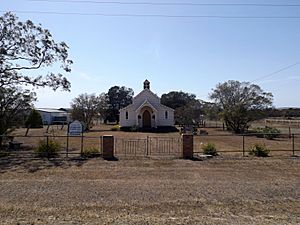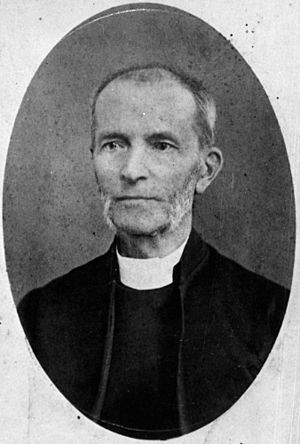St Anne's Anglican Church, Jondaryan facts for kids
Quick facts for kids St Anne's Anglican Church, Jondaryan |
|
|---|---|

Church building and grounds, 2014
|
|
| Location | Evanslea Road, Jondaryan, Toowoomba Region, Queensland, Australia |
| Design period | 1840s - 1860s (mid-19th century) |
| Built | 1859 - 1893 |
| Architectural style(s) | Gothic |
| Official name: St Annes Anglican Church, Jondaryan, Jondaryan Homestead church, St Anne's Church of England | |
| Type | state heritage (built) |
| Designated | 21 October 1992 |
| Reference no. | 600634 |
| Significant period | 1850s-1890s (historical) 1850s-1860s (fabric) ongoing (social) |
| Significant components | furniture/fittings, church, views to |
| Builders | Hugh Bradford |
| Lua error in Module:Location_map at line 420: attempt to index field 'wikibase' (a nil value). | |
St Anne's Anglican Church is a very old and special church located on Evanslea Road in Jondaryan, Australia. It's also known as the Jondaryan Homestead Church. This church was built way back in 1859 by a carpenter named Hugh Bradford. It started as a private chapel for a large farm called Jondaryan pastoral station. The very first church service was held there by a preacher named Benjamin Glennie later that year.
Over time, the church also served the nearby town of Jondaryan. In 1893, it was moved to where it stands today and changed a bit. Even now, regular services are held at St Anne's. It's also a small tourist spot because it's the oldest church still standing in the Darling Downs area, and one of the oldest in all of Queensland! Because of its history, it was added to the Queensland Heritage Register on October 21, 1992. Two other important places from the old Jondaryan farm, Jondaryan Homestead and Jondaryan Woolshed, are also listed separately.
Contents
The Church's Early Days
The St Anne's Church is made of timber slabs and is one of Queensland's oldest churches. It was first built in 1859 as a private chapel on the Jondaryan Station.
Jondaryan was a huge farm that started in 1842. It changed owners several times. In 1856, Robert and Edwin Tooth bought it. They were also involved in starting a brewery and a sugar company. Later, in 1858, Kent and Weinholt leased the farm and then bought it in 1863. James C. White managed Jondaryan for them.
Large farms like Jondaryan were like small villages. They had many employees and their families living there. The station provided homes for workers, a store, a blacksmith, and other important services. By 1870, Jondaryan had over 500 employees!
The first traveling minister for the Darling Downs was Reverend Benjamin Glennie. He started visiting the area in 1848. From 1850, he was based in Drayton. He held church services at many farms because the first church in Toowoomba wasn't built until 1856.
Building the Church
Going to church was important for the people living on the farm, both for their faith and for their community life. In 1859, James White, the manager, reportedly asked an architect from Melbourne to design a church for Jondaryan. The farm was planning many new buildings around 1860, including a new main house. Building the church might have been the first step in making the farm's facilities better.
An Irish carpenter named Hugh Bradford built the church. He used materials from Jondaryan and some that were brought in from Toowoomba. Reverend Benjamin Glennie held the first service in the new church on October 23, 1859. This important event was written down in his diary. Mr. White's wife, Anne, also ran a Sunday school for the children living on the station. Even though Reverend Glennie was Anglican, the church was open for use by other Christian groups among the Jondaryan workers.
Moving the Church
A town also called Jondaryan grew up nearby. It became more important after the Western railway line arrived in 1868. Even so, the town's success was closely linked to the farm. The St Anne's church on the farm remained the main place of worship for the town.
In 1893, there were very bad floods. The church was the only building on the farm that stayed above the water. Later that year, people decided to move the church to its current spot. This new location was about 1.6 kilometers (1 mile) from the Jondaryan town. Thomas Taylor, who owned the local hotel, donated the land for the church. He also gave a beautifully carved lectern to the church.
When the church was moved, some changes were made. A small room called a vestry was added. The ceiling and the special area for the altar, called the sanctuary, were lined. The main part of the church, the nave, had its floor lowered. The church then became part of the Anglican Diocese of Brisbane and was officially dedicated on December 18, 1893. A carved Bishop's chair, made from Queensland beech wood, was also given to the church at that time. The wooden pews and the silky oak prayer book case were made by the Jondaryan station carpenter.
Between 1988 and 1990, new concrete supports were added to help hold up the church walls. These new supports took over the job from the original timber stumps, which are no longer holding the main weight.
Today, regular services are still held at St Anne's Church. It continues to be a special place for the community and a popular spot for visitors.
What the Church Looks Like
St Anne's Church has a main hall, called a nave, with four sections. It also has a raised section of windows, called a clerestory, that lets in light. You enter the church through a small porch with a pointed roof. At the front, there's a chancel with a raised floor and its own lower roof. A small room called a vestry is on the south side. It has a lower floor than the rest of the church, and you reach it by steps.
The church building sits on timber stumps. The roof is made of corrugated iron and has a small bell tower, called a belfry, at the western end. The front and back of the building have decorative, scalloped wooden boards called barge boards. The church is mostly built with vertical timber slabs and battens. However, the east and west walls of the clerestory, the vestry, and the lower parts of the gable walls have chamfered timber slabs laid horizontally. The upper parts of these walls are covered with weatherboards.
The windows are narrow and tall, like lancets. The windows in the clerestory are square. The window in the sanctuary has borders of colored glass.
Inside, the roof is held up by special wooden frames called kingpost trusses and strong square hardwood posts. The walls of the clerestory and chancel are covered with horizontal pine boards. The rough-cut ironbark slabs of the main walls are visible in the aisles. The church is simply furnished with an altar table, a lectern (where readings are given), altar rails, and wooden pews for people to sit on.
Why St Anne's is a Heritage Site
St Anne's Anglican Church in Jondaryan was added to the Queensland Heritage Register on October 21, 1992. This means it's recognized as a very important historical place for several reasons:
- It shows how Queensland's history developed.
* St Anne's Church helps us understand how early large farms in Queensland were run like small communities. Jondaryan, managed by the Tooth family (who were important pioneers), had a "village" for its workers and their families.
- It's a rare and special part of Queensland's history.
* St Anne's is the oldest church still standing in the Darling Downs area. It's also one of the oldest churches in all of Queensland.
- It can teach us about Queensland's past.
* The church shows us examples of old building methods using materials that were found nearby.
- It's beautiful to look at.
* The church has a lot of charm and is very pleasing to the eye.
- It's important to the community.
* The church has a long and special connection with the families of Jondaryan and the people living in and around the town.
- It's connected to important people in Queensland's history.
* It's also linked to the life and work of Reverend Benjamin Glennie, who was the first Anglican minister in the Darling Downs area.


